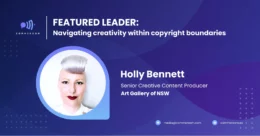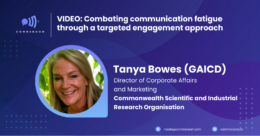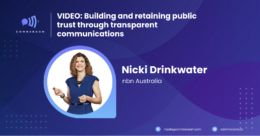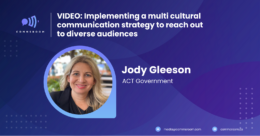Influence is undoubtedly the foundation of a transformative movement in public sector communication leadership. In this article, we embark on an enlightening journey into this realm with Centre for Strategic Communication Excellence, Managing Partner, Sia Papageorgiou, FRSA, FCSCE, SCMP.
How do you define influence in the context of communication leadership, particularly within the public sector?
“I define influence as the ability to shape perceptions, guide behaviours, and drive decision-making through strategic communication,” emphasises Sia, a seasoned expert in communication leadership. She gives prominence to the pivotal role of credibility and trustworthiness in this process, particularly in the fragile areas of the public sector.
Sia elaborates, “Empathy and understanding are key components of influence.”
She stresses the importance of deeply connecting with stakeholders and acknowledging their needs, concerns, and motivations. Building strong relationships through active listening and collaboration is fundamental for effective communication in the public sector.
Furthermore, she advocates for the power of strategic storytelling. ” Crafting and communicating a compelling narrative that aligns with the values and aspirations of your audience is vital,” she asserts. Communication leaders can garner support and drive positive change by showcasing success stories and illustrating the benefits of initiatives.
She explains the significance of empowering others in communication leadership as well. “Creating an environment where employees and stakeholders feel valued and motivated to contribute to the organisation’s goals creates a more inclusive and engaged community.”
“By encouraging participation and valuing diverse perspectives, you can drive strategic alignment and achieve positive outcomes for the community.”
In essence, Sia’s insights give great weight to the multifaceted nature of influence in communication leadership, offering valuable guidance for navigating its complexities.
How do you balance the need for transparency and confidentiality when communicating with executive stakeholders on sensitive or complex issues?
“First and foremost, it’s essential to understand the nature of the issue and the specific confidentiality requirements,” emphasises Sia. “This involves assessing what information can be shared openly and what must remain confidential due to legal, ethical, or strategic reasons. Clear guidelines and protocols are essential in making these determinations.”
When communicating with executive stakeholders, she brings up the necessity of transparency regarding the decision-making process. She suggests that providing a clear framework builds trust, even if some details remain private.
Additionally, Sia advises upfront communication about the boundaries of sensitive information to manage expectations effectively.
According to her, empathy and responsiveness to stakeholders’ concerns are equally important. Acknowledging the issue’s complexity helps foster trust while encouraging questions and sharing relevant information to maintain transparency without breaching confidentiality.
Lastly, regular follow-ups with stakeholders are crucial for maintaining trust and ensuring their inclusion and respect throughout the process. This ongoing communication reinforces trust and ensures stakeholders feel included and respected throughout the process.
Can you discuss the role of emotional intelligence in building influence as a communication leader, particularly in navigating challenging conversations and building rapport with stakeholders?
“Emotional intelligence is arguably one of the most important skills for professional and personal performance, and it is a communication leader’s most powerful asset,” states Sia. Emotional intelligence, or EQ, is the ability to identify and manage your own emotions and respond effectively to the emotions of others. While some may excel naturally, she points out that it can be learned, developed, and enhanced.
Emotionally intelligent leaders understand others’ thoughts and feelings. They listen attentively and consider emotions before making decisions. This ability fosters flexibility, effective collaboration, and meaningful relationships.
“One key aspect of emotional intelligence is self-awareness,” Sia explains. Being mindful of emotional responses helps leaders stay calm during high-stress situations. This self-regulation aids rational and strategic decision-making.
Empathy is crucial for understanding stakeholders’ perspectives and emotions. Leaders build trust and rapport by actively listening and showing genuine concern, fostering open and constructive dialogue.
Emotional intelligence also plays a role in conflict resolution. During challenging conversations, attuning to emotional undercurrents addresses underlying issues, finding common ground and facilitating win-win solutions.
Emotional intelligence helps establish strong relationships by building trust. Leaders create an environment of mutual respect and collaboration by being approachable and recognising contributions, which is critical for driving strategic alignment. Tailoring communication to different stakeholders’ preferences enhances a leader’s influence and effectiveness.
Can you share a specific instance where you faced resistance from executive stakeholders and how you overcame it to achieve your communication objectives?
Sia shared her experience at the Australian Taxation Office (ATO), where she implemented a new internal communication strategy to improve employee engagement and streamline processes.
“Initially, there was considerable resistance from several executive stakeholders,” she notes. “Their main concerns were the potential disruption to daily operations and the fear that increased transparency might lead to information overload and potential leaks of sensitive information.”
To address these concerns, Sia conducted a comprehensive needs assessment. She presented data highlighting the current communication gaps and their impact on employee productivity and morale.
Next, she organised workshops and one-on-one meetings with executive stakeholders. “I emphasised the benefits of the proposed changes, such as increased efficiency, better alignment with organisational goals, and enhanced employee engagement,” she said.
She proposed starting with a pilot program in a specific department to test the new practices on a smaller scale. This approach reduced perceived risks and demonstrated careful planning.
Sia also worked closely with security and compliance teams to ensure adherence to data protection and confidentiality standards.
“Ultimately, by addressing their concerns with data-driven insights, involving them in the planning process, and demonstrating quick wins, I was able to gain the support of the executive stakeholders,” she concludes. The new strategy led to a more engaged workforce, streamlined processes, and stronger alignment with the ATO’s goals.
Looking ahead, what do you believe will be the biggest challenges and opportunities for communication leaders in the public sector to build influence and drive strategic alignment?
Sia discusses the significant challenges and opportunities communication leaders face in the public sector. “One of the biggest challenges will be maintaining and rebuilding public trust in government institutions,” she says. With misinformation and public scepticism rising, communication leaders must prioritise transparency and consistency to rebuild credibility.
Engaging a wide range of stakeholders is complex but vital nonetheless. “Building strong relationships with government officials, community leaders, and the general public can facilitate collaboration,” she notes. This ensures communication strategies align with public needs and expectations.
She also states that another significant challenge is the rapid pace of digital transformation: public sector communication leaders must stay ahead of evolving technologies and embrace digital innovation. While daunting, it presents an opportunity to enhance engagement and streamline processes.
Effective communication with diverse audiences is of utmost importance. ” Ensuring our communication strategies are inclusive and culturally sensitive is essential,” she explains. This promotes a sense of belonging among all community members.
Crisis management is a perennial challenge in the public sector. “We need to be prepared to handle crises with clear, timely, and accurate communication,” Sia emphasises. This mitigates the impact of crises, maintains public order, and demonstrates the competence of public institutions.
On the opportunities side, she stresses the strategic use of data and analytics. “Leveraging data can provide insights into public sentiment and measure the effectiveness of our campaigns, guiding our strategic decision-making,” she states. Forming partnerships with other entities can amplify efforts and promote good practices.
Storytelling and narrative building offer powerful opportunities. “By crafting compelling narratives, we can humanise government initiatives and connect emotionally with the public,” she says. Empowering employees as brand ambassadors through strong internal communication can enhance organisational cohesion. When employees are well-informed and motivated, they become influential advocates for initiatives.
Finally, Sia points out that focusing on sustainability and social responsibility can resonate deeply with the public. “By highlighting our efforts in these areas, we can build a positive organisational image and inspire public confidence,” she concludes.
Read also: Navigating Crisis: A Proactive Approach to Communication Preparedness
Adrianne Saplagio is a Content Producer at Comms Room, where she combines her passion for storytelling with her expertise in multimedia content creation. With a keen eye for detail and a knack for engaging audiences, Adrianne has been instrumental in crafting compelling narratives that resonate across various digital platforms.


























Public feedback drives the 2024 Telecommunications Review
Read more